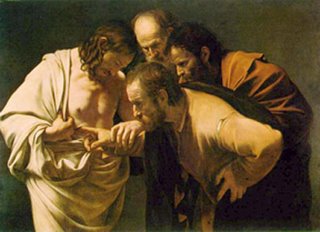You seek Jesus of Nazareth, the crucified. He has been raised; he is not here. (Mk 16:1-7)

If I were to choose a movie that would somehow illustrate the Paschal Mystery, it whould be The Chronicles of Narnia. The movie is obviously an allegory of the Passion, Death and Resurrection of Jesus Christ. It doesn’t take much of an imagination to identify Aslan, the Lion, with Jesus Christ and the White Witch with Satan.
I selected three sequences from the movie which I felt were closely related to the Paschal Mystery.
First SequenceThe first sequence is when the White Witch entered the camp of Aslan and demanded the surrender of Edmund. He was to be executed because he betrayed his brother and sisters. Then Aslan and the White Witch went to the tent for a conference. The conference ended with Aslan taking the place of Edmund. The innocent lion taking the place of the guilty Edmund. It is the innocent Jesus taking the place of sinful human beings.
Second SequenceThe second sequence is the execution and resurrection. Aslan willingly met his death at the hands of the White Witch on the Stone Table. While the White Witch engaged the followers of Aslan in battle, Lucy and Susan weep over Aslan. But lo and behold, Aslan disappears and then re-appears alive again.
Satan can not keep Jesus dead. Jesus is all-powerful. Nothing is impossible with Jesus. And so what is Jesus telling us at his resurrection? He assures us: “Fear not!” Why? Because Jesus is powerful, he can protect you, defend you, and help you.
“Fear not!” Why? Because Jesus is resurrected, he can be with you all the time and any place you go! The Resurrected Jesus assures us: “Fear not! For I am with you!”
Third SequenceThe third sequence is the battle sequence. When did the tide turn against the White Witch? When the resurrected Aslan entered the fray.
There is a battle going on inside us—the battle between good and evil. The battle ground is our heart. If we allow the Risen Lord to join us in this battle, we know for sure what will be the outcome—final victory for us.
But how do we get the Risen Lord to join us in this battle against evil?
First, through confession. How’s that? You see, going to confession is not just saying: “I have sinned. I am sorry. I repent.” Going to confession is also giving to God control over our lives. In other words, we are telling the Risen Jesus who battled and won against evil: “Please take command.”
Second, communion. Remember Elijah? He was running for his life. Jezebel was after his head. He was fed with bread by the angel of God. Having done that, he was able to walk 40 days and 40 nights until he reached the safety of the mountain of God. Biblical scholars say that the bread fed to Elijah is a foreshadowing of the Eu-charistic Bread.
The battle going in our hearts is a protracted battle. It will continue until the end of our lives. Where do we get the strength to continue fighting and never to give up? Communion. St. John Bosco used to say: “Communion is the bread that makes us strong.”
My Easter recommendations are:
- Get hold of the DVD of The Chronicles of Narnia. Watch it and nourish your soul.
- Do you need Jesus to re-assure you that he will always be there for you to protect you, or to help you or to comfort you? Make a poster or bookmarks with the words: “Fear not! For I am with you!”
- And finally, develop the sacramental spirituality of confession and communion. Hand over to God control over your life in confession and in communion let God give you the endurance and strength to battle sin and evil in your heart until the end of your life.




